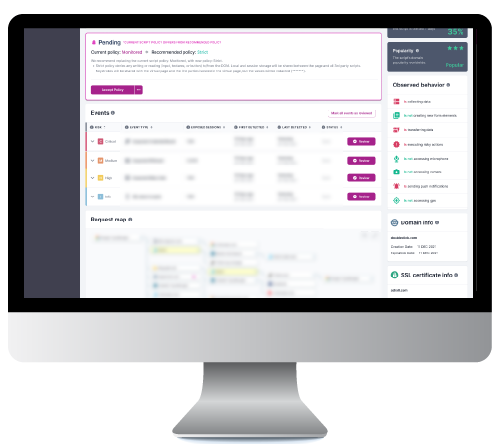ScriptSafe
Robust Web Security Solutions powered by Source Defense


Fortifying Client-side Web Security
Client-side security threats are widespread and continue to grow as attackers exploit vulnerabilities in web browsers, JavaScript, and third-party dependencies.
With the increasing complexity of modern web applications and the reliance on third-party scripts, the attack surface has expanded significantly.
Unlike server-side attacks, which focus on backend systems, client-side threats exploit weaknesses in JavaScript, third-party scripts, and user inputs to steal data, manipulate websites, or compromise user sessions.
ScriptSafe™ prevents unauthorized script execution, blocks malicious activity in real-time, and enforces runtime security policies, ensuring only trusted scripts execute as expected.
ScriptSafe Supports You in Meeting PCI DSS Requirements
Strengthen your organization’s compliance with PCI DSS requirements 6.4.3 and 11.6.1 by safeguarding cardholder data from payment page browser scripts. Here’s how ScriptSafe supports organizations in achieving compliance with these PCI DSS standards:
-
PCI DSS 6.4.3 – Script Monitoring
-
Verify script authorization – Ensure all scripts are approved and intentionally deployed.
-
Ensure script integrity – Detect and prevent unauthorized modifications.
-
Maintain a documented inventory – Track all scripts with written justification for their use.
-
-
PCI DSS 11.6.1 – Change and Tamper Detection
-
Real-time alerts – Receive notifications of any unauthorized script modifications.
-
Content & security monitoring – Evaluate security headers, detect script changes, and identify indicators of compromise.
-
Regular monitoring – Ensure scripts are reviewed and validated at least weekly.
-
Why Choose ScriptSafe?
ScriptSafe defends against all types of client-side security threats—including keylogging, formjacking, digital skimming, and Magecart—by extending web security from the server to the browser. It also ensures compliance with stringent data privacy regulations like PCI DSS, GDPR, and CCPA by preventing unauthorized data access or storage by third-party partners on your website.
Key Benefits of the ScriptSafe Platform
By implementing ScriptSafe’s solutions, organizations can enhance their client-side security posture, protect sensitive customer data, and maintain compliance with industry standards.
-
Prevents Client-Side Attacks
It blocks threats like Magecart, digital skimming, form jacking, and supply chain attacks before they can steal sensitive data. The software ensures that third-party scripts cannot be compromised to exfiltrate payment or personal information. -
Ensures Compliance with PCI DSS 4.0 & Other Regulations
The software helps meet PCI DSS 4.0 requirements (sections 6.4.3 and 11.6.1) for monitoring and controlling scripts. Prevents unauthorized data collection, supporting compliance with GDPR, CCPA, HIPAA, and other data protection laws. -
Real-Time Monitoring & Control
Provides a continuous inventory of all scripts running on a website. Allows security teams to monitor, justify, and control third-party and fourth-party scripts dynamically. -
Zero Trust for Third-Party Scripts
Enforces a zero-trust model by ensuring scripts only perform pre-approved, safe actions. Blocks unauthorized modifications, reducing the risk of supply chain attacks. -
Protects Sensitive Customer Data
Prevents unauthorized access to credit card details, login credentials, and PII. Eliminates risks associated with third-party JavaScript vulnerabilities. -
Reduces Operational Overhead
Automates script security instead of relying on manual audits and updates. Provides alerts and reports to simplify risk management. -
Enhances Brand Reputation & Customer Trust
Prevents website breaches that could result in financial losses, regulatory fines, and reputational damage. Strengthens customer confidence by securing online transactions and interactions. -
Easy Deployment with Minimal Performance Impact
Works seamlessly with existing website infrastructure. Does not impact website speed or user experience. -
Protects Against Future Threats
Uses behavior-based analysis to detect new and emerging threats. Provides proactive defense instead of reactive security measures.
Protecting Higher Education: A Complete Guide to E-Skimming Defense
As cyber threats evolve, higher education institutions face growing risks from sophisticated e-skimming attacks that target online payment portals, donation forms, and other web-based services handling sensitive cardholder data.
This guide explores the shifting e-skimming threat landscape, outlines key regulatory obligations, and offers practical strategies to help institutions build a robust and proactive defense.
Download the GuideComprehensive Client-Side Threat Detection & Alerts
ScriptSafe Detect is a powerful web security monitoring and alerting solution designed to safeguard data at the point of input. It provides a streamlined yet effective approach to data security and privacy compliance, addressing the growing risks posed by JavaScript, third-party vendors, and open-source code within your web environment.
With continuous scanning and real-time threat alerts, Detect empowers you to monitor and control third-party, fourth-party, and nth-party JavaScript—allowing you to take swift action against security and compliance risks.
Detect leverages external scanning, AI-driven detection algorithms, and advanced alerting to identify client-side threats and data privacy compliance violations in real-time.
- No code changes required – deploy seamlessly without modifying your site.
- Intelligent threat detection – optimized to minimize false positives and reduce unnecessary noise.
- Flexible scanning options – choose from multiple scanning frequencies to fit your needs.
- Scalable solutions – tailored packages available for small, medium, and large websites.


Real-Time Protection Against Client-Side Threats
Functioning as a real-time JavaScript sandbox, Protect isolates all scripts running on your website from the browser, preventing malicious code execution and unauthorized data access.
Protect delivers seamless, automated defense against client-side threats, acting as a real-time sandbox for all JavaScript running on your website—whether from your own code or third-party partners. It prevents malicious activity at the point of data input, ensuring security and compliance without disrupting site performance.
- Easy deployment – Just two lines of code to integrate.
- Real-time JavaScript isolation – Secures both first- and third-party scripts.
- Automated policy enforcement – Machine learning-assisted security controls.
- Full visibility & control – Manage access and permissions for all third-party tools.
- Scalable solutions – Tailored packages for small, medium, and large websites.
Choose Your ScriptSafe Solution
| Features | Detect Limited | Detect Standard | Protect Limited | Protect Standard |
|---|---|---|---|---|
|
Uses external scanning capability. |
||||
|
Uses a deployed JavaScript from ScriptSafe. Must be installed on the client website. |
||||
|
Scanning frequency is weekly. |
||||
|
Scanning frequency is real-time. |
||||
|
Scanning is performed for a single payment page. |
||||
|
Scanning is performed for all pages. |
||||
|
Alerting is configurable to include external email notification. |
||||
|
Semi-automatic (configurable) alerting on web header changes. |
Why Is Client-side Security Important?
Client-side security protects users, applications, and sensitive data from attacks that exploit vulnerabilities in the front end of a system. Here’s why it matters:
-
Protects Sensitive User Data
- Users enter personal, financial, and login information into web applications.
- Weak client-side security can expose this data to man-in-the-middle (MITM) attacks, cross-site scripting (XSS), and keyloggers.
-
Prevents Unauthorized Access & Account Hijacking
- Attackers can exploit insecure session management to hijack user accounts.
- Secure cookies, token-based authentication (JWT, OAuth), and session timeouts reduce risks.
-
Defends Against Cross-Site Scripting (XSS) & Injection Attacks
- XSS attacks allow hackers to inject malicious scripts that steal cookies, and credentials, or perform actions on behalf of the user.
- Input sanitization and Content Security Policy (CSP) can help mitigate these threats.
-
Ensures Secure Communication & Prevents Data Interception
- Without TLS/SSL encryption, attackers can intercept sensitive data (e.g., credit card details).
- The secure client-side implementation ensures encrypted communication.
-
Mitigates Clickjacking & Phishing Risks
- Clickjacking tricks users into clicking hidden UI elements, potentially approving transactions unknowingly.
- X-Frame-Options headers and frame-busting techniques prevent these attacks.
-
Prevents Malicious Code Execution & API Exploitation
- Attackers can manipulate frontend JavaScript to modify API calls or steal API keys.
- Using CORS policies, obfuscating sensitive logic, and limiting exposure to API keys can reduce risks.
-
Builds Trust & Compliance
- Users trust websites that are secure; breaches can lead to reputational damage and legal consequences.
- Compliance with GDPR, PCI DSS, HIPAA, and other security standards requires proper client-side protection.
-
Complements Server-Side Security
- Even with strong server-side security, a vulnerable front end can expose users to attacks.
- Secure both client-side and server-side to create a robust security posture.
Boosting Security in Your Web Ecosystem
Our behavior-based web application defense system continuously analyzes web application behavior to detect and mitigate unauthorized changes or malicious activities in real-time.
Top Client-Side Security FAQs
- First-party scripts authored in-house
- Third-party vendor scripts
- Fourth-party scripts loaded by those vendors
- Inline scripts, external libraries, and dynamically injected content
- Automatically maintaining an inventory of scripts on payment pages.
- Allowing only authorized scripts to run.
- Verifying script integrity.
- Monitoring and alerting for changes or malicious activity every seven days.
- Providing pre-formatted, requirement-specific reports to make evidence collection as simple as possible
<script> tag that references a URL outside the website’s domain.
Here are some examples of third-party JavaScript:
- Analytics & Tracking: These scripts help website owners track visitor behavior, gather insights, and improve user experience.
- Google Analytics: Tracks website traffic, user interactions, and demographics.
- Facebook Pixel: Monitors user interactions for ad targeting and conversion tracking.
- Advertising: These scripts help display ads, track impressions, and optimize revenue.
- Google AdSense: Displays targeted ads based on user activity.
- DoubleClick: Manages ad placements and real-time bidding
- Social Media: These scripts embed social media features, such as sharing buttons or comment sections.
- Facebook Like & Share Buttons: Allows users to like and share content.
- Instagram Embed: Embeds Instagram posts directly into a website.
-
Stored XSS (Persistent XSS)
-
The malicious script is permanently stored on the target server (e.g., in a database, comment section, or forum post).
-
When users visit the infected page, the script executes in their browser.
-
Example: A hacker injects a
<script>tag into a comment section, which steals cookies from anyone who views it.
-
-
Reflected XSS
-
The attack script is part of a URL or request and gets reflected off the server response.
-
It requires the victim to click a malicious link.
-
Example: A phishing email with a fake login page that runs a script to steal credentials.
-
-
DOM-Based XSS
-
The vulnerability exists in the browser-side JavaScript processing rather than the server response.
-
A script modifies the page’s DOM (Document Object Model) to inject malicious content.
-
Example: A website dynamically updates content based on URL parameters, allowing an attacker to manipulate the page.
-
Combating E-Skimming: A Campus-Wide Effort
Higher education institutions can transform their defense against e-skimming by combining cross-functional collaboration with specialized security solutions like ScriptSafe.
Transform Your Defense Against E-Skimming about the Combating E-Skimming: A Campus-Wide Effort

